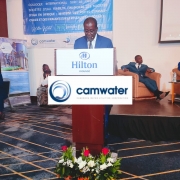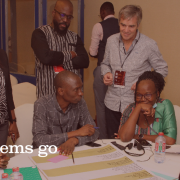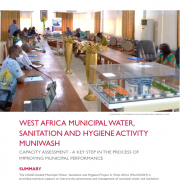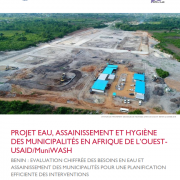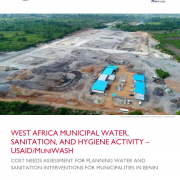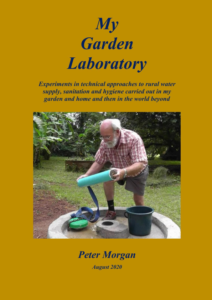The ultrasonic flowmeter is a tool for network performance control and preventive maintenance in handheld and fixed station. The principle of operation is the set of two (02) sensors on the same side of the pipe with sending of a wave on the side, which is reflected on the pipe that arrives on the second sensor. The 2nd sensor does the same thing and sends a signal which will be recovered by the other sensor. Depending on the direction of the flow rate and the speed, a difference in travelling time will be noted, which allows to measure the speed. As it applies to any measuring tool, the external diameter of the pipe or the wall thickness and the nature of the material should be set up.
The advantage of the ultrasonic flowmeter lies in its non-intrusive technology. It adapts itself to the environment and places itself on the pipe, without the need to take over the pipe or cut it. Moreover, it is not necessary to carry out important works for the setting up of the flowmeter. Its sensors allow it to adapt to different types of pipes, as they adjust to the pipe and can be installed on all types of networks, mainly in metal, non-metal network, PVC, PE, concrete, cement, asbestos, etc., ranging from 25 to 4700 in diameter.
The measurement is bi-directional and without loss of load because there is no contact with water. Sensors can be placed in different locations and require little space depending on the diameter and the nature of the material. The spacing between the sensors does not have to be very large.
The handheld tool is a small object that can be held in the hand, depending on the manufacturer and the pair of sensors, with a system that allows sensors to be tied to the pipe.
The fields of application are quite diverse. The ultrasonic flowmeter allows to control the performance of networks, in addition to or as an alternative to fixed sectorization, which is quite developed in the world. The performance of a drinking water network is controlled by measuring its flow rate, especially the night flow rate. The sectorization allows to identify the leaking sectors and to prioritize the research areas on which to carry out priority actions of leakage research, frauds, and network renewal, etc.
The watertight valves allow further reduction of the sectors through valve operations, changes in hydraulic sectors during the night, over several days or instantaneously depending on the research zones. They also allow to quantify the losses on the night flows rate, and then to carry out a ratio of the losses to check the performance of the network in the concerned areas to initiate or not corrective actions. They are further used to check the sectorization in place, especially the large meters and flowmeters that are already in fixed stations, which is a strategic focus for operators of water networks. The control is performed upon insertion, thanks to the presence of a fixed sensor that needs to be handled using an ultrasonic flowmeter, which can be an electromagnetic flowmeter, a mechanical meter, etc.
Some customers use it to check the large meters of big consumers before they validate the metering, given the financial impact of under-metering on large consumers. Data from the checking of fixed sectorization meters is used for the analysis of good or bad operation of a network. Failure to measure from the fixed meter has an impact on the operation and performance of networks. To check the pump flow rates, it is necessary to set the sensors on the pipes at the pump outlet and validate the nominal flow rate of the pump, i.e., identify if the pump is operating properly or if there is a need for maintenance.
It can be used upstream of works when defining the profiles of consumption, of distribution, of a suppressor, or the profile for the renewal of pipes. It is possible to set the device over several days to record the minimum, maximum and average flow rates, which will allow the correct dimensioning of works, i.e., avoiding having pipes or conduits that are too large or too small and using a suppressor adapted to the area.
Some images in the presentation below show the successive launch of four pumps to reach the desired flow rate in the drawdown to make the controls, and different examples of implementation. In the first example, the fixed insertion probe sends its data through a remote transmission system to the customer’s supervision software. The customer’s leak detection team had performed three unsuccessful researches for 20m3 of leaks in a specific area. Back to the starting point, there was a 20m3 difference between the handheld ultrasonic flowmeter that was set up and the insertion probe. The drift of insertion probe that occurred, resulted in a miscalculation of a measurement point and consequently a loss of operation due to the time spent to look for leaks where there were none.
Regarding the comparison with electromagnetic flowmeters, the connection with the flowmeter in place can sometimes run smoothly, but we can also observe electromagnetic interference defects on the electromagnetic meter that lead to a metering defect and a corrective action by the customer. In one of the cases encountered, one of the electromagnetic meters had got a large leakage rate, and the doubt of leakage was persisting. In fact, there was a 4 to 5 cubic meter difference that made it impossible to find the location of the leak, as the customer could not find their way around. The laying of an ultrasonic flowmeter allowed to detect the problem quickly. Example 2 (see presentation) is a DN300 stainless steel pipe on site where a pump flow rate had to be checked. The more the pipe will be larger, the greater will be the spacing between sensors. In case of no fixed flowmeter, it is possible to use the handheld ultrasonic flowmeter as a starting point to carry out checking for leaks, fraud and validate the proper functioning of a network. As a reminder, the minimum flowmeter is connected to the existing network.
That handheld measurement tool can be used by different departments: the distribution, performance and network department can be interested in leakage research feature, flow rate measurement feature and linear loss index ratio; production and maintenance department can use it to validate pump flows rate amongst other items that leaves the factory; metrology and metering department for the checking of fixed station meters; engineering offices and works department for the realization of hydraulic profit before works (e.g. modification of pipes, suppressors…) and quality department to validate performance of the network, etc.
Framework for the use of fixed ultrasonic flowmeter may varied. The handheld tool is multi-service and adapts itself to the environment. The use of fixed station is more restrictive, given the need to be tied to a point. Sensors are the same for handholding and fixed station. The difference lies in the unit, which will be fixed and close to the pair of sensors for the recovery of data from sensors and communication link with the remote transmission system for retransmission to a supervision software. The interest is obvious when it comes to large diameters of minimum DM400. Under that size, it is possible to use a fixed station to handle a fragile pipe, that one does not want to touch (the interest here lies in the non-intrusive side and the absence of important works for laying the equipment). However, it is suitable to be rigorous on the straight lengths to be respected for a better long-term precision.
The ultrasonic flowmeter is used for both drinking water and wastewater because the flow rates of condensate pumps are also checked by sanitation departments. The checking of flow rate pressure pumps with fixed station is also carried out for wastewater. To achieve the accuracy of wastewater measurement with the ultrasonic flowmeter, the pipe must be full. Sensors can be buried and immersed for a long time at fixed points. Pumps with inverters allow flow rate measurements to be tested even when water is loaded.
SEWERIN is a German manufacturer of equipment for improving the performance of water systems, mainly water leakage detection and Non-Revenue Water (NRW) improvement.

